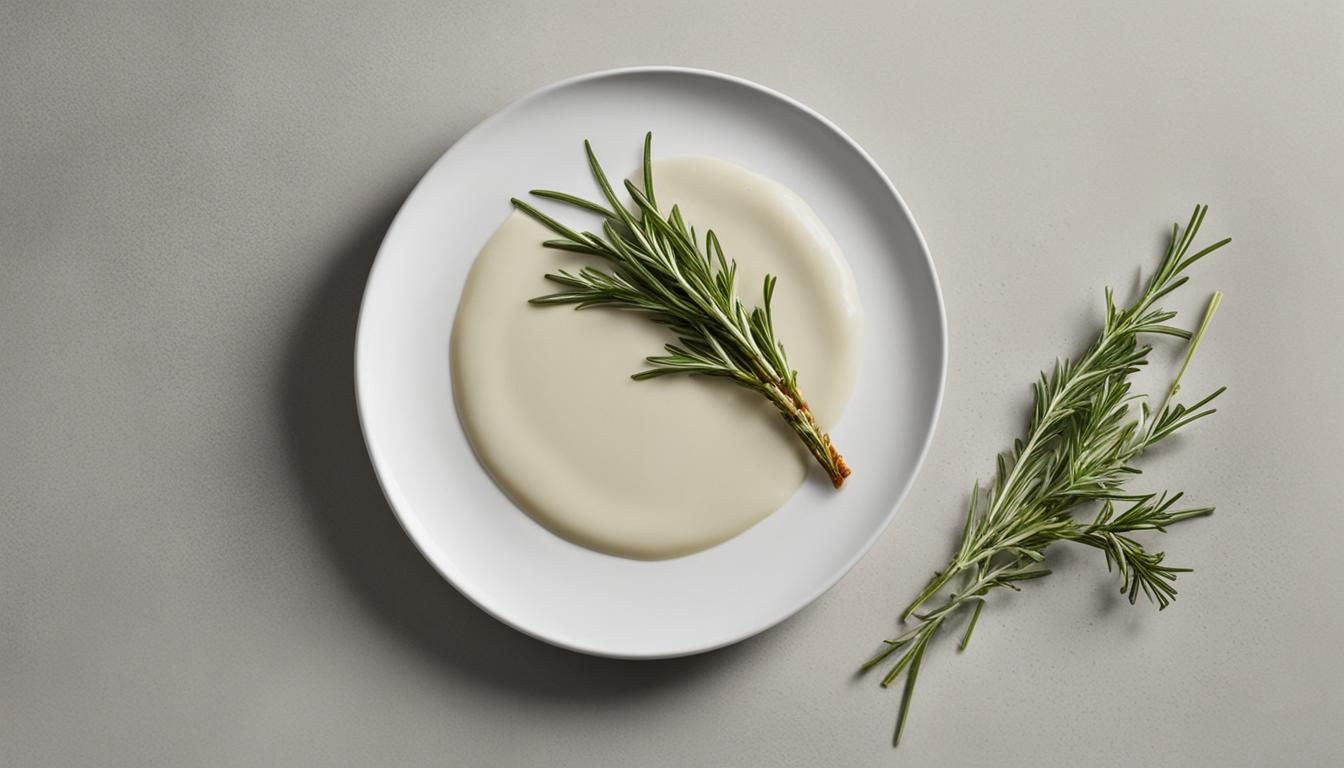Uncategorized
Cannabis Beurre Blanc Recipe: Elevate Your Meals
Are you looking to add a unique twist to your culinary creations? Look no further than this cannabis beurre blanc recipe. By incorporating cannabis-infused butter into a classic French beurre blanc sauce, you can elevate your meals to a whole new level. Not only does it add a subtle and intriguing flavor, but it also provides a kick that will leave your taste buds wanting more.
Creating the perfect cannabis beurre blanc requires attention to detail and careful heat management. You want to make sure the sauce doesn’t break, so it’s essential to use low heat and whisk constantly. The addition of champagne and citrus brightens the sauce, balancing its richness and adding a refreshing touch.
This versatile sauce pairs well with light meats such as fish, poultry, and pork. It can transform a simple dish into a gourmet experience, making it an excellent addition to any cannabis-infused meal.
Key Takeaways:
- Create a unique twist on classic beurre blanc by incorporating cannabis-infused butter.
- Use low heat and whisk constantly to prevent the sauce from breaking.
- The addition of champagne and citrus provides a balancing and refreshing touch.
- Pair the cannabis beurre blanc with light meats such as fish, poultry, and pork.
- Elevate your meals and add a touch of sophistication with this versatile sauce.
What is Beurre Blanc?
Beurre blanc is a French butter-based sauce that originated in Brittany, France. It is often referred to as beurre nantais, named after the city of Nantes in Brittany. Similar to hollandaise sauce, beurre blanc is an emulsified butter sauce that achieves a thick and creamy consistency. The sauce is made by simmering dry white wine with white wine vinegar and minced shallots until the liquid reduces. Cold cubed butter is then gradually whisked into the mixture, resulting in a creamy and flavorful sauce.
Key Characteristics of Beurre Blanc:
- Origin: Brittany, France
- Consistency: Thick and creamy
- Key Ingredients: White wine, white wine vinegar, minced shallots, cold cubed butter
- Preparation Technique: Simmering, whisking
I love how beurre blanc adds a luscious texture and buttery flavor to dishes. It’s a versatile sauce that can elevate a variety of meals, from seafood to poultry and even vegetables.
Let’s explore the history of beurre blanc and how it became a popular sauce in French cuisine.
Beurre Blanc vs. Hollandaise Sauce
| Characteristic | Beurre Blanc | Hollandaise Sauce |
|---|---|---|
| Origin | Brittany, France | French cuisine |
| Consistency | Thick and creamy | Rich and velvety |
| Key Ingredients | White wine, white wine vinegar, minced shallots, cold cubed butter | Egg yolks, butter, lemon juice, vinegar |
| Usage | Pairs well with light meats and vegetables | Served with eggs, fish, and vegetables |
The History of Beurre Blanc
Beurre blanc, a famous classic French butter-based sauce, has a rich history that spans several centuries. However, it was in the late 1960s, when Parisian chefs introduced and popularized the sauce among a wider audience, that it gained significant popularity. Although not considered one of the traditional “mother sauces” of French cuisine, beurre blanc shares similarities with hollandaise sauce in terms of its creamy texture and flavor.
The name “beurre blanc” translates to “white butter” in reference to the sauce’s distinctive opaque and creamy white color. Originally, beurre blanc was relatively unknown outside of the regions where it was prepared. But over time, it has evolved into a popular and versatile sauce that has found its way onto the menus of notable restaurants worldwide, cementing its place in the culinary landscape.
To fully appreciate the history of beurre blanc, it’s important to understand its cultural significance within French cuisine. French cuisine is renowned for its attention to detail, delicate flavors, and meticulous cooking techniques. Beurre blanc embodies these characteristics and showcases the elegance and sophistication of French culinary traditions.
“Beurre blanc’s journey from a regional specialty to a widely recognized and cherished sauce is a testament to its timeless appeal and the passion of the chefs who introduced it to the world.”
Nowadays, beurre blanc is enjoyed not only in high-end French restaurants but also in-home kitchens, where adventurous cooks seek to recreate the flavors of classic French cuisine. Its simplicity and versatility have made it a favorite among chefs and home cooks alike, allowing them to elevate a wide range of dishes with its buttery richness and subtle flavors.
The Rise of Beurre Blanc in Modern Cuisine
While beurre blanc has a long-standing history, it wasn’t until the late 1960s that it gained widespread acclaim. Parisian chefs, known for their creativity and innovation, recognized the potential of this exquisite sauce and introduced it to the culinary scene beyond its original regional boundaries. They incorporated beurre blanc into their menus, pairing it with delicate seafood dishes, poultry, and other light meats, highlighting the sauce’s ability to enhance the flavors of various ingredients.
“The rise of beurre blanc in modern cuisine can be attributed to the vision and talent of Parisian chefs who saw the potential in this simple yet elegant sauce, transforming it into a culinary masterpiece.”
Over time, beurre blanc became a staple in French restaurants, elevating dishes with its luxurious texture and delicate taste. The sauce’s popularity eventually spread to international fine-dining establishments and home kitchens worldwide, where it continues to impress discerning palates and add a touch of French sophistication to meals.
| Key Points |
|---|
| Beurre blanc has a rich history that dates back several centuries |
| Parisian chefs introduced and popularized beurre blanc in the late 1960s |
| Beurre blanc is known for its creamy texture and delicate flavor |
| The name “beurre blanc” translates to “white butter” |
| Beurre blanc has evolved into a popular and versatile sauce worldwide |
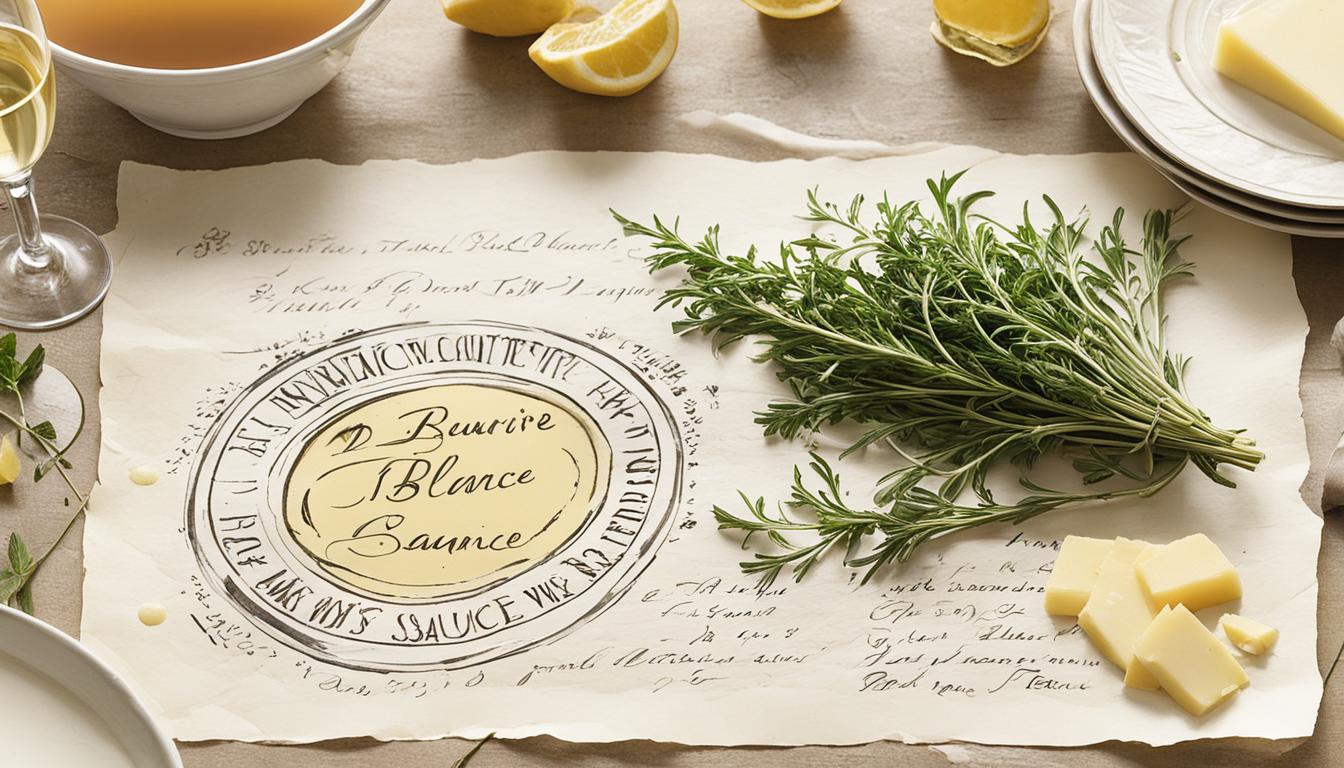
The Ingredients of Beurre Blanc
Beurre blanc is a decadent French butter sauce that elevates the flavors of various dishes. To create this velvety sauce, you will need a few key ingredients that come together to make a harmonious blend. Here are the essential ingredients for preparing beurre blanc:
1. White Wine
A crucial component of beurre blanc is dry white wine. Opt for a crisp and tart variety to balance the flavors of the sauce. Avoid using oaky or buttery wines, as they can overpower the delicate taste of beurre blanc.
2. White Wine Vinegar
The addition of white wine vinegar helps to enhance the acidity of the sauce, creating the perfect balance of flavors. It contributes to the tangy notes that make beurre blanc so irresistible.
3. Shallot
Minced shallots are a key ingredient that adds depth and complexity to beurre blanc. The shallots impart a subtle yet distinctive flavor profile that elevates the overall taste of the sauce.
4. Butter
Quality butter is a crucial element in creating a rich and luscious beurre blanc. Opt for unsalted butter with a higher fat content, as it will provide a more flavorful result. The butter should be cold and cubed, allowing it to gradually melt into the sauce as you whisk.
5. Salt
A pinch of salt is all you need to season the beurre blanc and bring out the natural flavors of the other ingredients. Add salt to taste, ensuring the sauce is perfectly seasoned without being overly salty.
Together, these ingredients create the foundation of a classic beurre blanc sauce. With their harmonious union, you can achieve a velvety, buttery sauce that complements a wide range of dishes. The next section will outline the step-by-step process of making beurre blanc, so you can bring this delicious sauce to life in your own kitchen.
Making Beurre Blanc – The Process
Making beurre blanc is a beautiful art that requires precision and attention to detail. This delicate sauce is achieved through a careful process of simmering, whisking, and managing the heat. Let me guide you through the steps to create a perfect beurre blanc sauce.
The first step is to gather all the necessary ingredients, including white wine, white wine vinegar, minced shallots, cold butter, and salt. It’s important to use a good-quality saucepan that distributes heat evenly for optimal results.
- Start by simmering the white wine, white wine vinegar, and minced shallots in the saucepan. Allow the mixture to reduce until you are left with a flavorful base.
- Once the liquid has reduced, it’s time to whisk in the cold butter. Gradually add the butter while whisking constantly to maintain a stable emulsion.
- Managing the heat is crucial during this process. Adjust the burner or move the pan on and off the heat to maintain the right temperature. The butter should melt and emulsify with the other ingredients without breaking.
- Continue whisking until all the butter is incorporated and the sauce has a smooth and creamy consistency.
- Finally, season the beurre blanc with salt to taste. Remember, a little bit of salt goes a long way in enhancing the flavors.
And there you have it! Your homemade beurre blanc sauce is ready to elevate your dishes with its rich and buttery flavor. Now, let’s take a look at the heat management and whisking techniques that are crucial for achieving a perfect beurre blanc.
Heat Management and Whisking Techniques
Heat management is key when making beurre blanc to prevent the sauce from breaking. Here are some tips:
- Use a good-quality saucepan that distributes heat evenly to prevent hot spots.
- Whisk constantly to maintain a stable temperature throughout the process.
- If the sauce gets too hot, remove it from the heat or reduce the burner’s intensity to prevent the butter from separating.
- If the heat is too low, the butter may not melt properly. Adjust the heat accordingly to ensure the butter emulsifies with the other ingredients.
Now that you know the key steps and techniques for making beurre blanc, let’s move on to the next section and explore different ways to serve and customize this versatile sauce.
Serving and Variations
Beurre blanc is a versatile sauce that can be served immediately after preparation. It is recommended to serve it warm rather than hot to prevent breaking. Warm plates should be used to avoid chilling the sauce upon serving. Straining the sauce through a fine-mesh strainer is optional but can result in a smoother texture.
Beurre blanc pairs well with a variety of dishes, including fish, chicken, pork, beef, and vegetables. The sauce can be easily customized by using different wines or adding lemon juice for a lemon beurre blanc. The sauce offers endless possibilities for flavor variations.
| Variation | Ingredients | Instructions |
|---|---|---|
| Lemon Beurre Blanc | White wine, lemon juice, minced shallots, butter, salt | Mix white wine and lemon juice with shallots, reduce. Gradually whisk in butter. Season with salt. |
| No-Wine Beurre Blanc | Water, white wine vinegar, minced shallots, butter, salt | Simmer water, white wine vinegar, and shallots, reduce. Gradually whisk in butter. Season with salt. |
| Herb Beurre Blanc | White wine, minced shallots, mixed herbs (e.g., thyme, parsley, chives), butter, salt | Simmer white wine and shallots with mixed herbs, reduce. Gradually whisk in butter. Season with salt. |
Serving Suggestions
- Grilled salmon: Drizzle beurre blanc over a perfectly grilled salmon fillet for a burst of flavor.
- Pan-seared chicken: Serve beurre blanc alongside a tender and juicy pan-seared chicken breast.
- Roasted pork loin: Elevate a succulent roasted pork loin by spooning beurre blanc on top.
- Sautéed vegetables: Toss your favorite vegetables in beurre blanc for a delightful side dish.
“The versatility of beurre blanc allows it to complement a wide range of dishes, enhancing their flavors and providing a touch of elegance.”
Tips and Tricks for Beurre Blanc
When it comes to making beurre blanc, heat management is crucial to prevent separation and maintain the emulsion. Here are some valuable tips and tricks that will help you create a perfect beurre blanc sauce:
1. Use a Good-Quality Saucepan
To ensure even heat distribution, it’s important to use a saucepan that conducts heat effectively. This will help prevent hot spots and keep your sauce smooth and creamy.
2. Constant Whisking
Whisking constantly during the preparation process is essential. It helps to maintain a stable temperature and emulsify the sauce, preventing it from breaking.
3. Adding Butter
While it’s generally recommended to add butter in small increments, you can also add it all at once. The key is to ensure that the butter melts while remaining emulsified.
4. Saving a Broken Sauce
If your sauce starts to break, don’t panic! Adding a splash of cool water and whisking vigorously can help bring it back together. Be sure to whisk rapidly to re-emulsify the sauce.
5. Timing is Everything
Beurre blanc is best prepared right before serving. As time passes, the sauce becomes more prone to breaking. If you need to hold the sauce, you can keep it warm by submerging a metal container in warm water or using a sous-vide immersion circulator set to a low temperature.
6. Thickening Over Time
If your sauce thickens over time, don’t worry. Adding a tablespoon or two of water and whisking it in gently can help restore the desired consistency.
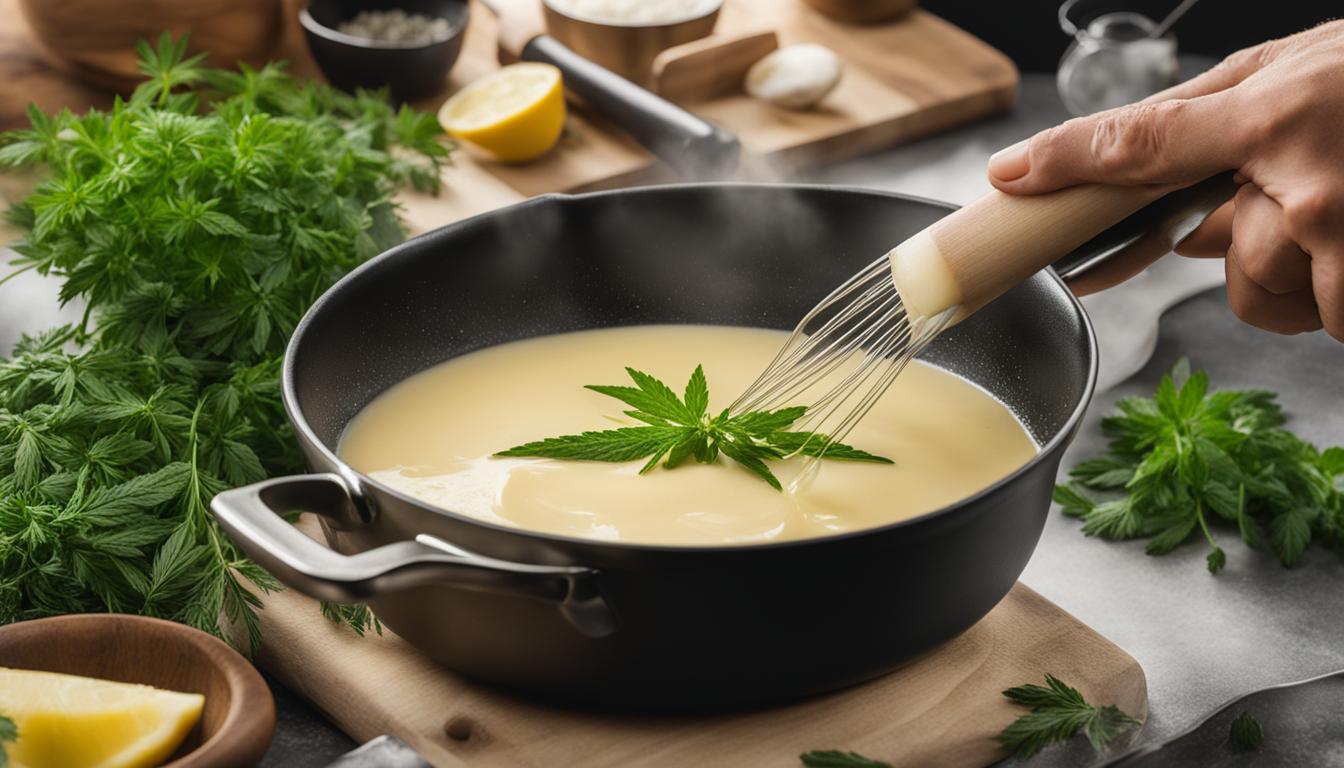
Now that you have these helpful tips and tricks, you’re ready to tackle beurre blanc like a pro. Remember, beurre blanc is a versatile sauce that can elevate any dish with its creamy and flavorful profile.
Non-Alcoholic Version
If you prefer a non-alcoholic version of beurre blanc, you can substitute the white wine with water and lemon juice. This allows you to enjoy the flavors and texture of beurre blanc without the inclusion of alcohol. The rest of the recipe remains the same, with the reduction of water and lemon juice replacing the white wine and vinegar mixture. This variation provides a refreshing and citrusy twist to the sauce.
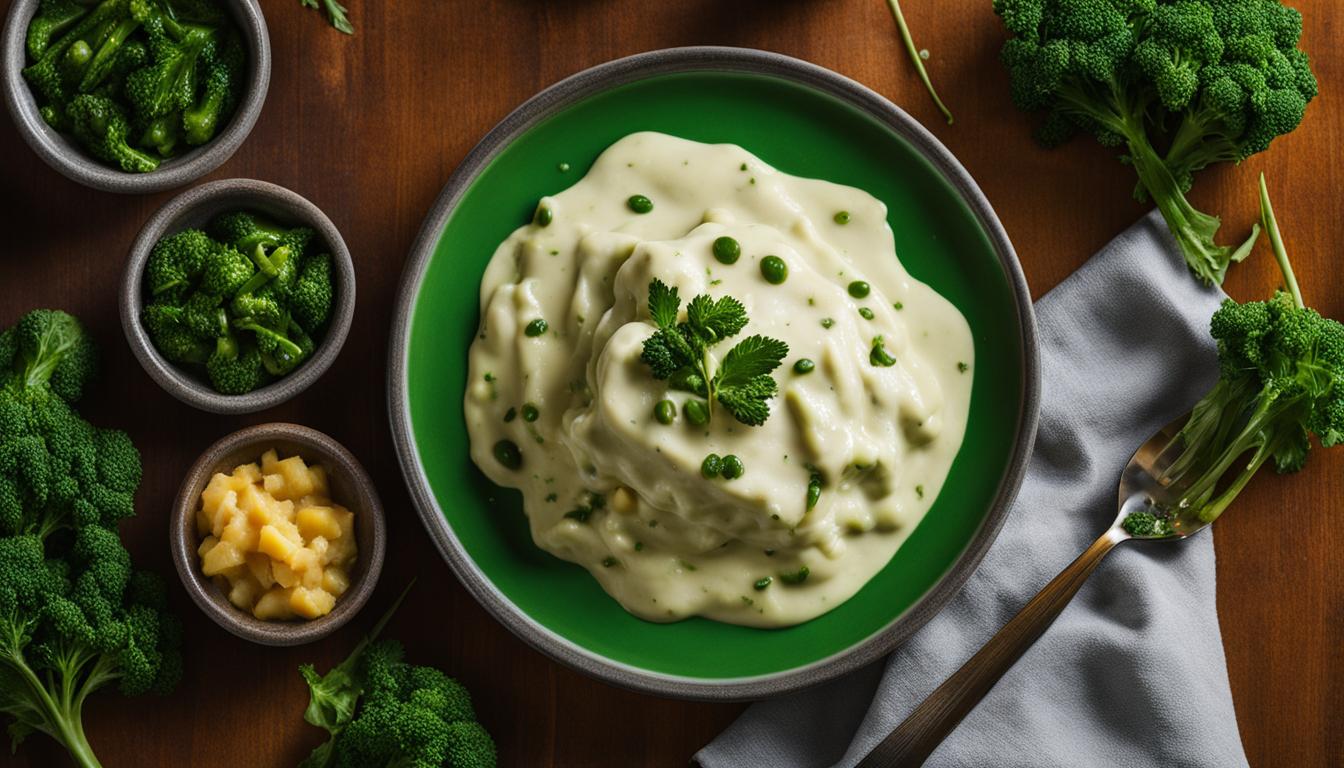
| Ingredients: | Quantities: |
|---|---|
| Water | 1 cup |
| Lemon juice | 1/4 cup |
| Minced shallots | 1 tablespoon |
| Cold butter, cubed | 1 cup |
| Salt | To taste |
To prepare the non-alcoholic beurre blanc:
- In a saucepan, combine the water, lemon juice, and minced shallots.
- Simmer the mixture over medium heat until it reduces by half.
- Gradually whisk in the cold butter, adding a few cubes at a time. Continue whisking until all the butter has melted and the sauce is thick and creamy.
- Season with salt to taste.
- Serve the non-alcoholic beurre blanc warm with your favorite dish.
Enjoy the citrusy and alcohol-free twist of this non-alcoholic beurre blanc, perfect for those who prefer to avoid alcohol in their meals.
Creamy Beurre Blanc
To achieve a creamy variation of beurre blanc, heavy whipping cream can be added to the sauce. This addition creates a thicker consistency similar to alfredo sauce. The cream should be cooked with the white wine and vinegar mixture until it becomes very thick. The remaining steps of adding butter, whisking, seasoning, straining, and serving are the same. The addition of cream enhances the richness of the sauce and allows it to remain warm for a longer period without breaking.
Here’s a table summarizing the process of making creamy beurre blanc:
| Ingredients | Instructions |
|---|---|
| White wine | Cook the wine with shallots and heavy whipping cream until the mixture is reduced and thick. |
| White wine vinegar | |
| Minced shallots | |
| Heavy whipping cream | |
| Cold butter | Add cold butter gradually, whisking constantly until emulsified. |
| Salt | Season the sauce with salt (and pepper, if desired). |
| Strain the sauce for a smoother consistency (optional). | |
| Serve and enjoy! |
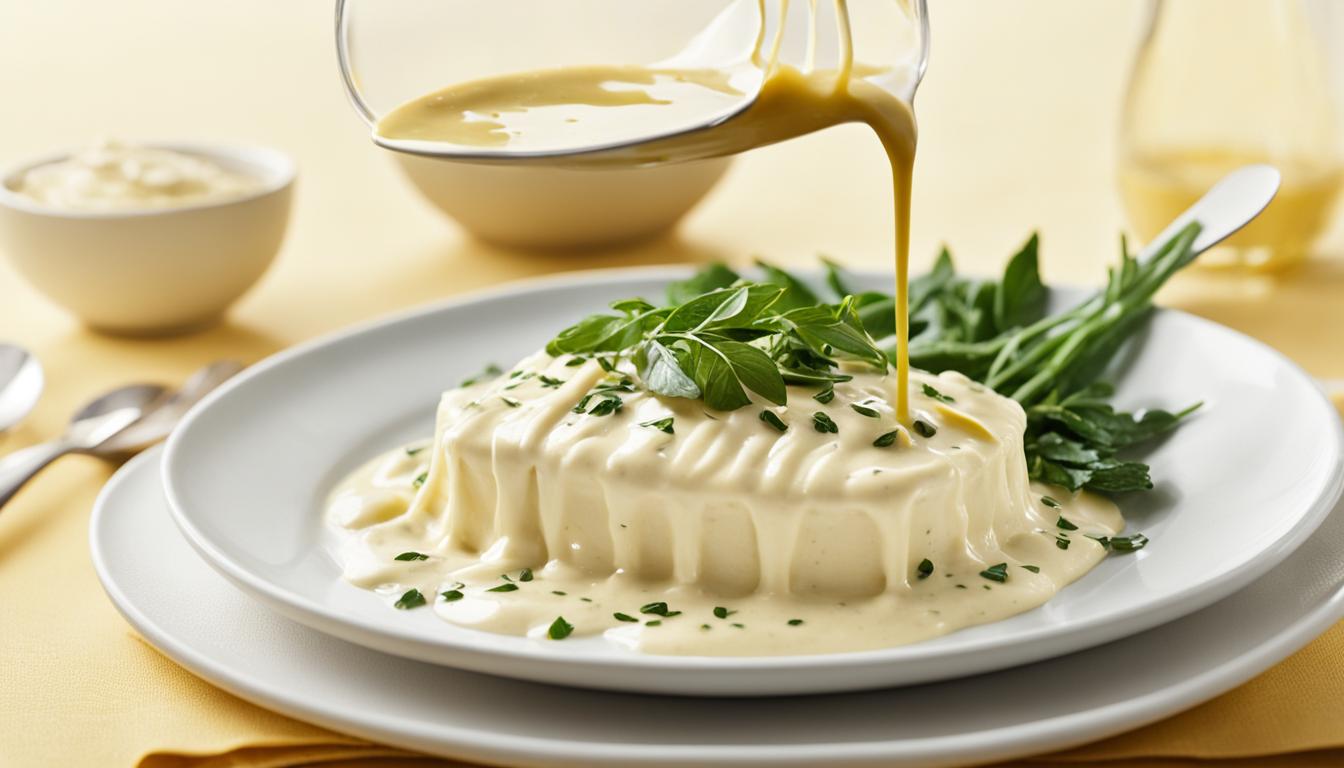
Expert Tips and Serving Suggestions
When it comes to serving beurre blanc, there are a few expert tips and suggestions that can elevate your dish and ensure a delicious dining experience. Here are some key considerations:
1. Shallots in Sauce
Beurre blanc is traditionally made with minced shallots, which not only add flavor but also provide a pleasant texture to the sauce. The shallots release their aromatic qualities during the simmering process and create a rich base for the sauce. Leaving the shallots in the sauce adds a delightful burst of flavor with every bite.
2. Straining for a Smooth Consistency
If you prefer a smoother consistency for your beurre blanc, you can strain the sauce through a fine-mesh strainer. This step helps remove any small pieces of shallot and creates a velvety texture. Straining is optional and ultimately depends on your personal preference.
3. Water for Saving Broken Sauce
Beurre blanc can occasionally break or separate during preparation. But don’t worry, there’s a simple trick to save your sauce. When you notice the sauce starting to break, add a splash or two of cool water and whisk vigorously. The water helps to re-emulsify the sauce, bringing it back together and saving the texture. Rapid whisking is key here to promote the re-emulsification process.
4. Serve Immediately for Optimal Flavor
To fully enjoy the rich flavor and optimal texture of beurre blanc, it’s important to serve it immediately after preparation. This sauce is at its best when it’s warm and freshly made. Using warm plates for serving can help maintain the right temperature and prevent the sauce from chilling too quickly.
5. Pairing Versatility
Beurre blanc is a versatile sauce that complements a wide range of dishes. It pairs exceptionally well with vegetables, such as asparagus or steamed broccoli, adding a touch of indulgence and acidity. Additionally, it beautifully enhances the flavors of light meats like chicken, pork, beef, and fish. Whether you’re creating a simple weeknight meal or hosting a dinner party, beurre blanc is sure to impress.
Now that you’re armed with these expert tips and serving suggestions, you’ll be able to prepare and serve beurre blanc like a pro. Enjoy the richness, flavor, and versatility that this classic French sauce brings to your culinary endeavors.
| Serving Suggestions: |
|---|
| 1. Vegetables (asparagus, steamed broccoli) |
| 2. Chicken |
| 3. Pork |
| 4. Beef |
| 5. Fish |
Recipe and Serving Details
Now that you know the basics of making beurre blanc, let’s dive into the recipe and serving details. This classic French sauce is surprisingly simple to prepare and adds a touch of elegance to any dish.
Classic Beurre Blanc Recipe
Here is the traditional recipe for making beurre blanc:
- Combine 3/4 cup of dry white wine, 1/4 cup of white wine vinegar, and 2 tablespoons of minced shallots in a saucepan.
- Simmer the mixture over low heat until it has reduced to about 2 tablespoons.
- Reduce the heat to low and gradually whisk in 1 cup (2 sticks) of cold cubed butter, one piece at a time, until melted and emulsified.
- Continue whisking until the sauce is smooth and creamy.
- Season with salt to taste.
- Optional: If desired, strain the sauce through a fine-mesh strainer for a smoother texture.
Remember to use a good-quality saucepan with even heat distribution to prevent the sauce from breaking. And don’t forget to whisk constantly throughout the process to maintain a stable emulsion.
Serving Beurre Blanc
Beurre blanc is best served immediately after preparation to maintain its optimal texture and flavor. It pairs beautifully with a wide range of dishes, adding richness and acidity to enhance their flavors. Here are some serving suggestions:
- Drizzle beurre blanc over grilled or poached fish fillets for a seafood delight.
- Top steamed or roasted vegetables with a spoonful of beurre blanc for a gourmet touch.
- Indulge in the classic combination of beurre blanc and pan-seared scallops.
- Enhance the flavors of roasted chicken or grilled pork chops with a generous spoonful of this velvety sauce.
- Make your beef tenderloin or filet mignon even more decadent by serving it with a side of beurre blanc.
With its versatility and rich flavor, beurre blanc is sure to impress your guests and elevate your meals to a whole new level.
Conclusion
In summary, beurre blanc is a delightful French butter sauce that has become a staple in kitchens around the world. With its origins in Brittany, France, this sauce has a rich history and a reputation for adding elegance and richness to a variety of dishes. The process of making beurre blanc requires careful heat management and constant whisking to achieve the perfect emulsion.
What makes beurre blanc truly special is its versatility. You can customize the sauce by using different wines and adding your own unique flavors. Whether you prefer the classic version or want to add a modern twist with cannabis infusion, beurre blanc is sure to elevate your culinary creations.
Beurre blanc is a perfect accompaniment to light meats, such as fish, poultry, and pork, as well as vegetables. Its creamy texture and the balance of flavors make it a favorite among chefs and food enthusiasts alike. So, the next time you want to add a touch of sophistication to your meals, reach for beurre blanc and indulge in its rich, buttery goodness.
FAQ
What is cannabis beurre blanc?
Cannabis beurre blanc is a modern twist on the classic French butter sauce, beurre blanc. It incorporates cannabis butter, adding both a kick and a subtle flavor to the dish.
How do you make cannabis beurre blanc?
To make cannabis beurre blanc, follow the basic recipe for beurre blanc and substitute regular butter with cannabis-infused butter. The rest of the process remains the same.
What are the ingredients for beurre blanc?
The basic ingredients for beurre blanc include dry white wine, white wine vinegar, minced shallots, cold butter, salt, and optionally pepper.
How do you make beurre blanc sauce?
To make beurre blanc sauce, simmer white wine, white wine vinegar, and minced shallots until the liquid reduces. Gradually whisk in cold cubed butter until melted and emulsified. Season with salt and optionally pepper.
What dishes does beurre blanc sauce pair well with?
Beurre blanc sauce pairs well with light meats such as fish, poultry, and pork. It also complements vegetables and can be a versatile addition to various dishes.
How do you prevent beurre blanc from breaking?
To prevent beurre blanc from breaking, it is important to use low heat, constant whisking, and careful attention. Adding butter in small increments and managing the heat can help maintain the emulsion.
Can beurre blanc sauce be made without alcohol?
Yes, a non-alcoholic version of beurre blanc can be made by substituting the white wine with water and lemon juice.
How can beurre blanc be customized?
Beurre blanc can be customized by using different wines or adding lemon juice for a lemon beurre blanc. The sauce offers endless possibilities for flavor variations.
Should beurre blanc be strained?
Straining beurre blanc is optional, as the minced shallots provide additional flavor and texture. However, straining can result in a smoother consistency if desired.
Can broken beurre blanc sauce be saved?
If beurre blanc sauce starts to break, adding a splash or two of cool water and whisking vigorously can help save it. Rapid whisking promotes the re-emulsification of the sauce.
How should beurre blanc be served?
Beurre blanc should be served immediately after preparation, preferably warm but not hot. It pairs well with a variety of dishes, adding richness and acidity to enhance their flavors.

